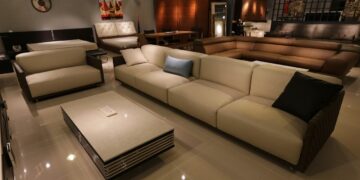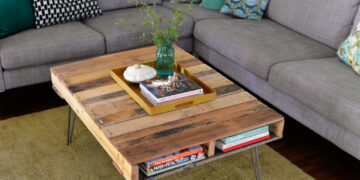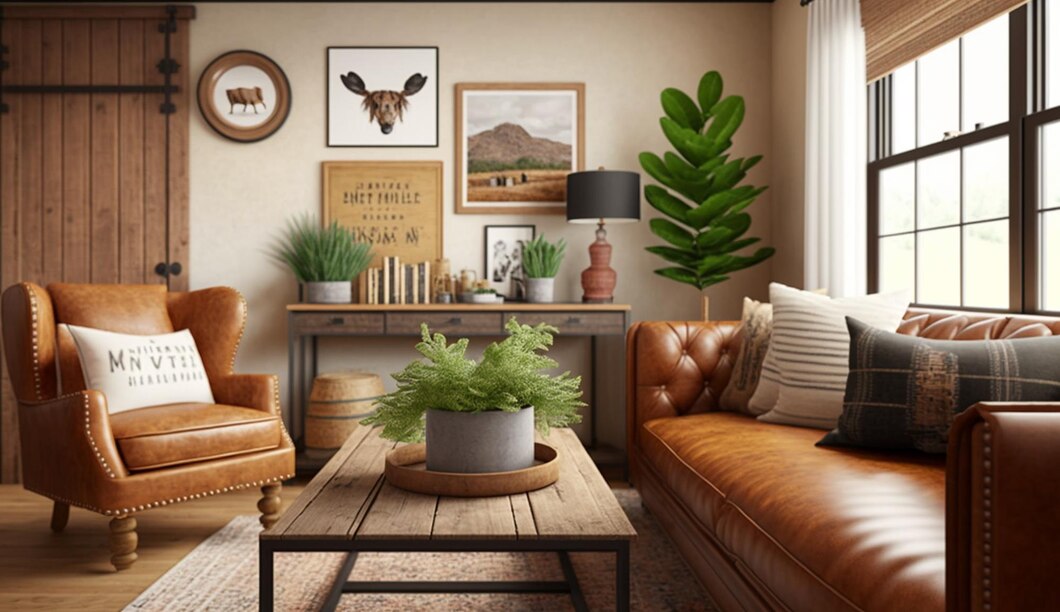Sustainable Chic: The Artful Fusion of Eco-Friendly Furniture in Modern Abodes
Sustainable and Stylish: The Rise of Eco-Friendly Furniture in Modern Homes
A New Era of Conscious Living
In today’s world, where environmental issues are at the forefront of our collective consciousness, the concept of sustainable living has become a necessity rather than a mere choice. As our understanding of the impact we have on the planet grows, so does our desire to align our lifestyles with eco-friendly practices.
The furniture industry, recognizing this pivotal shift, has embraced sustainability as a guiding principle for the design and production of home furnishings. This article delves into the fascinating realm of eco-friendly furniture and explores its significance in modern homes.
Defining Sustainable Furniture
Before diving into the intricacies of sustainable furniture, it is crucial to establish a clear definition. Sustainable furniture refers to pieces that have been consciously crafted using materials and processes that minimize harm to the environment throughout their lifecycle.
From sourcing renewable materials to reducing waste generation and energy consumption during manufacturing, sustainability encompasses various aspects that contribute to creating a greener future.
The Importance in Modern Homes
In an era marked by rapid urbanization and heightened awareness about environmental conservation, sustainable furniture plays an essential role in modern homes. As homeowners seek ways to reduce their carbon footprint and live more responsibly, integrating eco-friendly furnishings becomes paramount.
Sustainable furniture not only addresses environmental concerns but also enhances indoor air quality by reducing harmful off-gassing from toxic chemicals often found in traditional furniture materials.
The Trend Towards Eco-Friendly Furniture
The shift towards eco-friendly furniture represents a significant societal trend that continues to gather momentum with each passing year. More people are recognizing the importance of making conscious choices when furnishing their homes and transforming their living spaces into showcases for sustainable design.
This growing awareness has sparked a demand for eco-friendly furniture that is both aesthetically pleasing and environmentally responsible. With this trend on the rise, manufacturers and designers are embracing the challenge of creating pieces that seamlessly blend sustainability with style.

The Environmental Impact of Traditional Furniture
Exploration of the negative effects of traditional furniture production on the environment
Traditional furniture production has long been associated with a range of detrimental impacts on the environment.
One major concern is deforestation and habitat destruction caused by logging, specifically for wood-based furniture. Vast areas of forests, home to diverse ecosystems and countless species, are cleared to meet the demand for timber.
This leads to irreversible damage to natural habitats and disrupts delicate ecological balance. Moreover, as forests disappear, their ability to act as carbon sinks diminishes, exacerbating global climate change.
Deforestation and habitat destruction caused by logging for wood-based furniture
The logging industry plays a significant role in supplying wood for traditional furniture production. This relentless pursuit of timber not only contributes to deforestation but also leads to extensive habitat destruction.
Innumerable animal species that depend on these ecosystems for survival are displaced or face extinction due to the loss of their natural habitats. Additionally, deforestation disrupts local water cycles and soil fertility while contributing to soil erosion and increasing susceptibility to natural disasters such as landslides.
Emissions from manufacturing processes, including toxic chemicals and greenhouse gases
Another environmental concern arising from traditional furniture production is the emissions generated by manufacturing processes. These emissions include toxic chemicals released during various stages, such as painting, staining, and finishing wooden furniture pieces.
These chemicals can contaminate air and water sources near factories, posing health risks not only to workers but also to surrounding communities. Furthermore, greenhouse gas emissions produced during manufacturing contribute significantly to global warming.
Landfill waste generated by non-biodegradable materials used in traditional furniture
The use of non-biodegradable materials in conventional furniture manufacturing contributes heavily to landfill waste accumulation. Materials like plastics and synthetic fabrics take hundreds or even thousands of years to break down naturally, clogging landfills and harming the environment. Additionally, the disposal of unwanted or outdated furniture leads to further waste generation.
As these items end up in landfills, they contribute to greenhouse gas emissions and pose a long-term threat to soil and water quality. By understanding the negative effects of traditional furniture production on our environment, it becomes imperative to seek alternative solutions that prioritize sustainability and minimize environmental harm.

The Birth of Eco-Friendly Furniture
Emergence of sustainable design principles in response to environmental concerns
As the world grappled with the devastating effects of climate change and the depletion of natural resources, designers and manufacturers began to recognize the urgent need for more sustainable practices in the furniture industry. This shift in mindset led to the emergence of sustainable design principles, which aimed to minimize environmental impact without compromising style or functionality.
Designers started incorporating concepts like cradle-to-cradle design, where products are designed with their entire lifecycle in mind, ensuring that materials can be easily reused or recycled. Additionally, there was a growing focus on reducing waste, energy consumption, and harmful emissions throughout the furniture production process.
Introduction of innovative materials and manufacturing techniques for eco-friendly furniture production
Parallel to the embrace of sustainable design principles was an influx of innovative materials and manufacturing techniques that revolutionized eco-friendly furniture production. Designers sought out alternative resources that were renewable, recycled, or reclaimed from waste streams.
These materials included bamboo, a fast-growing plant with impressive strength and versatility; reclaimed wood sourced from old buildings or salvaged timber; and even recycled plastics derived from post-consumer waste like bottles and containers.
Moreover, manufacturers implemented new techniques such as low-VOC (volatile organic compounds) finishes that reduced air pollution caused by traditional paints and coatings. They also invested in energy-efficient machinery and processes to minimize carbon emissions during production.
This marriage of sustainable design principles with innovative materials and manufacturing techniques marked a significant turning point in the evolution of eco-friendly furniture. It demonstrated that style-conscious consumers no longer had to compromise their aesthetic preferences while making more environmentally responsible choices for their homes.
Sustainable Materials in Furniture Design
Bamboo: An incredibly versatile and rapidly renewable resource with a minimal carbon footprint
Sublime Sustainability: Harnessing the Power of Bamboo Bamboo, an astonishingly versatile plant, has captivated designers and homeowners alike as a sustainable solution for furniture design.
Being one of the fastest-growing plants on Earth, it replenishes itself within a few years, making it an excellent renewable resource. Bamboo’s growth cycle is truly remarkable.
From its initial shoot, which can grow up to three feet in just 24 hours, to its maturity within three to five years, this plant surpasses the pace of traditional timber sources. This rapid growth not only allows for frequent harvests but also significantly reduces the risk of deforestation.
Furthermore, bamboo’s sustainability benefits extend beyond its growth rate. As a grass rather than a tree, bamboo does not require replanting once harvested; instead, it regenerates naturally from its extensive root system.
This characteristic prevents soil erosion and helps maintain healthy ecosystems. Additionally, bamboo cultivation requires minimal water resources compared to traditional timber crops.
Examples of bamboo-based furniture designs that showcase durability and aesthetic appeal
Sustainable Sophistication: Exquisite Bamboo Furniture Designs Bamboo’s versatility extends beyond its sustainability; it also offers exceptional durability and aesthetic appeal as a furniture material. With its high tensile strength comparable to steel and exceptional flexibility properties, bamboo can withstand heavy use without compromising structural integrity.
Innovative designers have ingeniously incorporated bamboo into various furniture styles to showcase its full potential.
From sleek modern chairs with curved frames that highlight bamboo’s natural beauty to sturdy dining tables adorned with intricate woven patterns showcasing craftsmanship at its finest, these designs demonstrate how sustainable materials can elevate interior spaces by seamlessly blending style and environmental consciousness.
Reclaimed Wood: Giving new life to salvaged timber with unique characteristics and history
A Tale of Redemption: The Significance of Reclaimed Wood Reclaimed wood has emerged as a compelling choice in eco-friendly furniture design, embodying the essence of sustainability and historical preservation. Salvaged from old barns, factories, or even sunken logs retrieved from rivers, reclaimed wood possesses unique characteristics that tell captivating stories.
Utilizing reclaimed wood in furniture not only prevents valuable resources from going to waste but also reduces the demand for newly logged timber. By repurposing discarded or forgotten materials, we can actively contribute to minimizing deforestation and habitat destruction.
Additionally, reclaimed wood often boasts remarkable resiliency due to its exposure to the elements over time. Knots, weathering, and distinct patterns weave tales of endurance into each piece.
Examples of creative ways reclaimed wood is incorporated into modern furniture designs
Rustic Revival: Unleashing the Beauty of Reclaimed Wood Designers have embraced the rustic charm and inherent character found in reclaimed wood to create stunning pieces with soulful narratives.
From artfully crafted dining tables showcasing rich patinas that reflect decades-old history to cosy bed frames embodying warmth and nostalgia – these designs demonstrate how recycled timber can infuse spaces with a sense of timelessness while reducing environmental impact.
By seamlessly integrating reclaimed wood into modern furniture design, these creations bridge the gap between sustainability and aesthetics, urging us all to appreciate the value of preserving our natural resources while enjoying functional yet visually captivating pieces.
Recycled Plastic: Transforming waste into functional and stylish pieces
From Trash to Treasure: The Creative Resurgence of Recycled Plastic Recycled plastic has emerged as an ingenious solution for transforming post-consumer waste into durable and visually striking furniture. This material’s abundance in our throwaway culture presents an opportunity to divert plastic from landfills while breathing new life into discarded resources.
Exploring the realm of recycled plastic furniture reveals a vast array of possibilities. By repurposing items like plastic bottles, bags, and packaging waste, manufacturers can create sturdy chairs, tables, and even outdoor lounges that not only withstand the test of time but also contribute to reducing environmental pollution.
The versatility of recycled plastic allows for intricate designs, vibrant colours, and even the replication of traditional materials such as wood or metal. In embracing recycled plastic furniture, we actively combat the harmful effects of excessive waste generation while showcasing artistic innovation that challenges preconceived notions about sustainability and style.
Eco-Friendly Manufacturing Processes
Adoption of sustainable practices such as energy-efficient production methods
With increasing awareness of environmental issues, furniture manufacturers have started adopting sustainable practices to minimize their carbon footprint. Energy-efficient production methods have become the cornerstone of eco-friendly furniture manufacturing. Companies are investing in renewable energy sources, such as solar and wind, to power their factories.
Additionally, they are integrating advanced technologies that optimize energy usage during production processes. By reducing energy consumption and reliance on fossil fuels, these manufacturers not only mitigate their impact on the environment but also contribute to the overall sustainability of the industry.
Explanation on how water-based adhesives reduce harmful emissions compared
In traditional furniture manufacturing, solvent-based adhesives were often used for bonding different components together. However, these adhesives contain volatile organic compounds (VOCs) that can be harmful to both human health and the environment. Eco-friendly furniture manufacturers have shifted towards using water-based adhesives as a safer alternative.
Water-based adhesives significantly reduce VOC emissions during application and curing processes. Not only do they provide a healthier working environment for factory workers but also contribute to improving air quality by minimizing harmful substances released into the atmosphere.
Conclusion
As sustainability becomes an increasingly integral part of our lives, eco-friendly furniture has emerged as a testament to our commitment towards a greener future.
Through the adoption of sustainable materials like bamboo and reclaimed wood, along with innovative manufacturing processes that prioritize energy efficiency and reduced emissions through water-based adhesives, eco-friendly furniture provides both style and conscience for modern homes.
By choosing environmentally conscious options when furnishing our living spaces, we actively participate in nurturing a planet that can thrive for future generations.
























